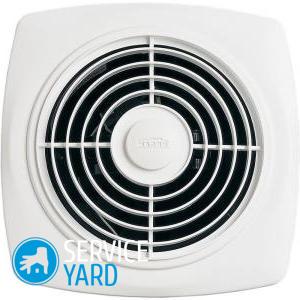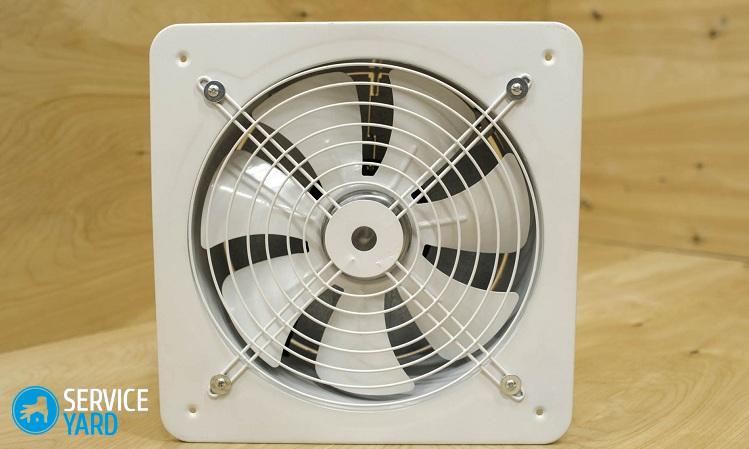Installing a fan in the bathroom

The process of installing a fan in the bathroom does not require as much time as preparing for this work. To get down to business, you need to draw up a clear plan of action, study the electrical wiring of the apartment, decide on the type and model of the ventilation system, and also choose the way to turn on the hood. In this article, we will examine why such a device is needed, and directly what the installation of a fan in the bathroom looks like.
to contents ↑Why do I need a fan in the bathroom?
As a rule, the hood in the bathroom is not needed in all cases. If a standard ventilation system does its job well, then it is not necessary to spend time installing a more efficient system. But if the underlying system is ineffective, then serious problems may arise:
- Bad smells.
- Lack of oxygen.
- The destruction of tiles.
- Condensation on the mirrors, walls.
- The emergence and development of pathogens (mold, fungus).
If any of the above problems occurs, it is advisable to check the standard ventilation for functionality. To do this, take a match and bring it to the air duct grille. If at the same time the match flame goes out or stretches towards the ventilation, then the system works. But if the fire continues to burn without any changes, we can safely conclude that the standard duct does not work.
to contents ↑Important! In some rare cases, the standard ventilation process can be resumed. But to do this yourself, you will have to spend a lot of time. In addition, the aesthetic appearance of the bathroom can be seriously affected during the repair process.
What is required to install a fan?
In order for the installed fan in the bathroom to function for a long time and cope with its duties, it is necessary to create favorable conditions for it:
- The bathroom must have a properly working ventilation duct. In case of clogging and similar problems after installing the fan, the system will not function. Thus, before installing the device, thoroughly clean the duct.
- When buying a device, you need to carefully study its technical characteristics. The purchased fan must fully comply with all operating conditions of a particular bathroom. Much attention should be paid to functionality, efficiency indicators, the level of generated noise and cost.
- Since the ventilation system of the bathroom is completely based on replacing moist air with fresh, care must be taken about its source. For this, as a rule, you will have to equip a 2-cm hole under the door. With the help of these simple steps, fresh air will flow into the bathroom through the gap made.
to contents ↑Important! It is worth paying attention to the fact that the independent installation of a fan in the bathroom requires a responsible attitude to this process. Thus, by the time of installation, all the nuances should be taken into account and thought out. Ideally, it is best to draw up a detailed work plan and follow the instructions. If you experience any complications, it is recommended to seek help from specialists.
Preparatory work before installation
First of all, you need to decide on the model of the device itself. The selected fan must fully comply with the operating conditions. It is advisable to use devices that have the following layout:
- The timer for self-switching off and on the device if necessary.
- Hydrostat, so that the level of humidity in the bathroom is also under control.
Important! As a rule, bathrooms use fans that have all the necessary characteristics, including a timer, moisture resistance and independence from an uninterrupted power supply.
When installing the hood with your own hands, you must carefully examine the wiring, since it is from it that the device will be powered in the future. In general, installing an exhaust fan in the bathroom requires:
- Install the device directly into the ventilation duct.
- Self-service gaskets.
- Sealing of joints with putty and mounting foam.
Power Operation
The usability of the installed fan is directly affected by both the technical capabilities of the device and the way it is turned on. For each of the installation methods, as a rule, a unique fan connection diagram is needed. All the required schemes and drawings can be easily found on the network at various specialized forums.
Before finally deciding on the choice of the method of turning on the device, it is necessary to study in detail all the positive and negative sides. This is the only way to avoid problems with inconvenience.
Through the lighting
In some cases, the most convenient way is to turn on the fan simultaneously with the lighting of the bathroom. That is, every time someone enters the bathroom, the hood automatically turns on. So, when the light is turned off, the ventilation system is also deactivated.
The main problem of this method of inclusion is the inability to use a timer, which is why the device does not have time to clean the air in the room while a person is in the bathroom. In addition, if a non-silent fan is installed, it will not be very convenient to take a bath at night due to vibration and noise.
Important! Also, do not forget that connecting this device to the same line with lighting can also cause technical problems with an insufficiently responsible approach to work. From this we can conclude that it is probably better to contact specialists, and not make an independent installation of the fan in the bathroom.
Using a cord
Many fan models initially have their own switch. Typically, this turns off takes the form of a cord that comes out of the case. When manipulating the cord (pulling down), the fan turns on or off.
Important! It should be noted that this option of turning on the device is most often inconvenient. This is due to the high location of the ventilation duct (almost under the ceiling). In addition, sometimes you have to install the hood in hard-to-reach places, which is why direct access to it is seriously limited.
This method of turning on and off will become the most convenient in case of repair work. In addition, you can safely, in addition to the main cord, lay an additional wire and independently install a switch for the fan. However, it should be borne in mind that when laying wiring outside repair work, the aesthetics of the walls of the bathroom can seriously suffer. It is also worth remembering the need to connect the hood with the main wiring.
Self (automatic) inclusion
With this option of turning on the device, it can be either turned on or off manually. But at the same time, in the active state, the fan will analyze the situation in the bathroom itself and, if necessary, be deactivated. A motion sensor, timer or hydrostat may be responsible for analyzing the bathroom.
Important! It is worth noting that most often a fan with an automatic shutdown system is equipped in such a way as to be activated when people are detected in the room and turned off by the built-in timer. But be that as it may, such devices are not in great demand because of the rather high cost.
Self switch
When installing a fan in the bathroom, you can conduct separate wiring for the device by connecting it through an independent switch. The option of turning on the device through the cord is completely analogous to this method, however, it is slightly more convenient due to the lack of the need for direct access to ventilation.
The most common is the method of turning on using a two-key switch, that is, at the exit from the bathroom, instead of a conventional light switch, a new one with two keys is installed.
to contents ↑Important! Such a switch is not suitable only if the room has an increased level of humidity.
Wiring
When working with laying the wires, it is necessary to proceed from the instructions, as well as safety precautions. Under no circumstances should you work with active electrical wiring - housing must be completely de-energized before the installation process.
In the process of connecting wires to each other, it is strongly recommended to use special terminals. Using these connections, the contact between the wires will be much better.
to contents ↑Important! Copper wiring should also be connected to the fan (ventilation duct). Ideally, it should be carried out in the process of cosmetic repairs. If repair is not planned yet, wiring is carried out on top of the wall covering.
Installation work
As a rule, in the configuration of the fan, you can see special instructions for installing the fan. In addition, there should be all instructions for the further use and care of this device. All subsequent work must be carried out in strict accordance with the requirements.
Installation of the device takes much less time than all preparatory work. So, installing a fan in the bathroom will take about 15 minutes:
- Remove the front of the fan.
- Apply silicone or glue to the wall where the appliance is connected to the walls.
- Carefully place the appliance in the air duct; press it firmly for several minutes.
- Fasten the cover with self-tapping screws. Often all the necessary elements are supplied with the device.
Important! In addition to the basic installation work, it is recommended to install a mosquito net on top of the fan in front of the grill.
On this installation can be considered complete. After mounting the device, but before closing its cover, as a rule, you need to connect the fan to the previously made wires.
to contents ↑Important! Failure to comply with safety standards can cause serious problems, among which are: unstable power supply of the entire apartment, short circuit or inoperability of the fan itself.
Stock footage
So the question is how to install a fan in the bathroom, can be considered exhaustively disclosed. All incomprehensible nuances can be easily found in various specialized forums, or again carefully read the instructions that came with the device.
- How to choose a vacuum cleaner taking into account the characteristics of the house and coatings?
- What to look for when choosing a water delivery
- How to quickly create comfort at home - tips for housewives
- How to choose the perfect TV - useful tips
- What to look for when choosing blinds
- What should be running shoes?
- What useful things can you buy in a hardware store
- Iphone 11 pro max review
- Than iPhone is better than Android smartphones




